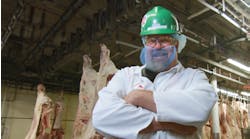The pandemic made lots of businesses appreciate their floor workers. Hershey was no exception, says Tim Hinegardner, vice president of manufacturing.
“One of the great things culturally, getting through the pandemic and out the other side, is it just helped reinforce how central manufacturing is to everything that Hershey does,” Hinegardner says. “There’s no candy or salty snacks or ‘moments of goodness,’ as we talk about it, without our employees and our operations that make those snacks.”
Managing Hershey’s manufacturing is a complicated undertaking even in normal times. To feed its ever-evolving portfolio of chocolate, other candy and savory snacks, Hershey relies on a network of 22 global manufacturing plants, including 11 confection plants in North America (counting one under construction in Hershey, Pa.) and seven savory snacks plants. Other facilities support distribution, ingredient processing and other functions.
Confectionery production has some unique difficulties, in both the actual process and its scheduling. Sugar, cacao and other main ingredients are notoriously unpredictable and difficult to work with. Much of the production equipment is specialized and unique to the industry, making it especially challenging in some cases to obtain and maintain. Candy is notoriously seasonal, with consumption revolving around the major holidays of Halloween, Christmas and Easter. Production must be able to accommodate these surges and ebbs in demand, as well as unexpected ones.
And when it came to unexpected demand, the pandemic was a lulu.
The pandemic turned out to be a fine opportunity for Hershey: Consumers craved comfort food, and what’s more comforting than candy? As Hinegardner puts it: “Hershey traditionally does very well in complex times.”
But being in a good position due to market trends is only the start of the battle. You have to anticipate those trends accurately, then put yourself in a position to respond to them. Hershey did that with one simple principle: “Lead in all we do.”
“For us, we made a very good strategic decision upfront when the pandemic started in March 2020,” Hinegardner says. “Everyone was trying to figure out how long this was going to be and what are we going to do. We made the decision that we’re going to keep our employees safe and follow all the federal guidance and state guidance, but we were going to keep running.”
Leaning in to production sounds like the obvious strategy. But like a lot of things at the beginning of the pandemic, what is obvious in hindsight was considerably murkier at the time.
“While many of our competitors were doing business as usual or even shutting down, thinking it was a two-week blip, we leaned in - on production and also on optimizing what we’re producing,” Hinegardner says. “So I think we were able to take advantage of some of that market share during that timeframe, which has only continued.”
He says that three core manufacturing principles got Hershey through the pandemic: people-first manufacturing, technology and reliability. The focus will remain on those areas going forward.
People-first manufacturing
During the pandemic, people-first manufacturing first meant ensuring the safety of all our employees, stabilizing staffing for all positions, dealing with attrition and filling positions that came up because of new products or SKUs.
The pandemic taught Hershey some valuable lessons about its workforce, which it will try to apply in the future, Hinegardner says: “What we thought was the operating model pre-pandemic – it’s a different workforce now.”
One of the biggest such lessons was the importance of screening employees up front. As Hinegardner says, manufacturing is not a career for everyone, and it’s better to give them a good sense through the interview and onboarding process of what the job entails. “It’s not like working from home. There’s a lot of process discipline, but there’s a lot of great cultural pieces too, as you create this connectivity in the plant and career growth opportunities.”
Employees now get an in-person interview and an aptitude test that measures mechanical and mathematical abilities. When an employee is hired, the onboarding process takes about a week, covering basics like an overview of the plant, a description of the job, safety procedures and quality standards. They then start working under close supervision by a trainer. After a set amount of time – usually a few weeks – the employee is brought back into the classroom for a review of what has been learned.
Hershey used to do all the orientation, onboarding and initial training up front, over several weeks, Hinegardner says. “But we’ve found it’s better to get you into the basics, especially with people safety, food safety, then get you out to understand your job, then bring you back so you can take what you’ve learned so far on the floor and put it together from a bigger plant standpoint.” Training is an ongoing process, with some tasks taking up to six months to learn.
Technology
As with many food companies, packaging is where Hershey’s automation is the most developed. It’s the easiest to automate, since it’s a high-speed, continuous operation. Molding and other operational aspects are just as well developed in automation at Hershey, Hinegardner says.
He sees material handling as the operational area with the biggest potential for automation at Hershey, both bringing ingredients in and getting pallet loads of product onto outgoing trucks. The stakes are especially high right now, when certain ingredients are getting hard to source.
Hinegardner identifies artificial intelligence as a technology with potential to help the supplier situation by predicting availability. AI can help with other aspects, like production scheduling and worker scheduling.
A long-term technological initiative will be tying together Hershey’s software systems. Meshing production software with enterprise planning software is what Hinegardner calls the next big step.
“That's one of the areas we're working on,” he says. “I see that's the future – how do you tie all these digital tools together so it's not necessarily human intervention trying to decide what the most important factors are in the day-to-day business.”
Reliability
All food companies strive for consistency in their products, but it can be elusive with new products. And Hershey brings in new products and SKUs every year.
Hinegardner says that while Hershey tries to keep to a core of products, “we're always going to have this need to be flexible and agile to be able to modify some of our items.” The company keeps experimenting with new flavors, especially savory-sweet combinations like Reese’s Cups filled with potato chips or pretzels.
Reliability also means being able to fill customer orders, and a reliable supply of ingredients is necessary for that. During the pandemic, Hershey realized that the just-in-time model it had been using for supply delivery wasn’t working; it couldn’t accommodate wide shifts in demand.
“It’s a very complex supplier network, and if you think about pre-pandemic, it was a just-in-time type of environment,” he says. “Very high turn, very low inventory. It’s not just-in-time anymore. There are too many disruptions, between supplier disruptions post-pandemic or the Ukrainian war and other types of things.”
Hershey started building buffer supplies of certain vital ingredients, which would have been unheard of about 10 years ago, and will maintain that agility.
Hershey’s immediate future challenge will be staffing and bringing online extra production lines. Ten of them are planned for 2023 and 2024.
“One of the great success stories for this year is we've stabilized the workforce and hired to where we have enough labor to run our current operations,” Hinegardner says. “So now we have our base stable load. The focus is staffing in advance as we start up new operations.”

